Job Growth & Unemployment
Posted on 04/23/2019 by Beverly Kerr
- Austin added 22,700 net new jobs, growth of 2.1%, in the 12 months ending in March, making Austin the 16th fastest growing major metro.
- Wholesale trade was Austin’s fastest growing industry (8.2%) while professional and business services added the most jobs (6,000) over the last 12 months.
- Austin's seasonally adjusted unemployment rate is 2.7%, down from 2.9% in February.
The Austin metropolitan area added 22,700 net new jobs, or 2.1%, in the 12 months ending in March, according to Friday's releases of preliminary payroll jobs numbers by the Texas Workforce Commission (TWC) and the U.S. Bureau of Labor Statistics (BLS).

Austin’s 2.1% growth makes it the 16th best performing among the 50 largest metro areas.[1] Dallas,gaining 3.5%, made the top ten. Houston (up 2.2%), San Antonio (2.1%), and Fort Worth (1.9%) ranked 13th, 17th and 19th respectively.
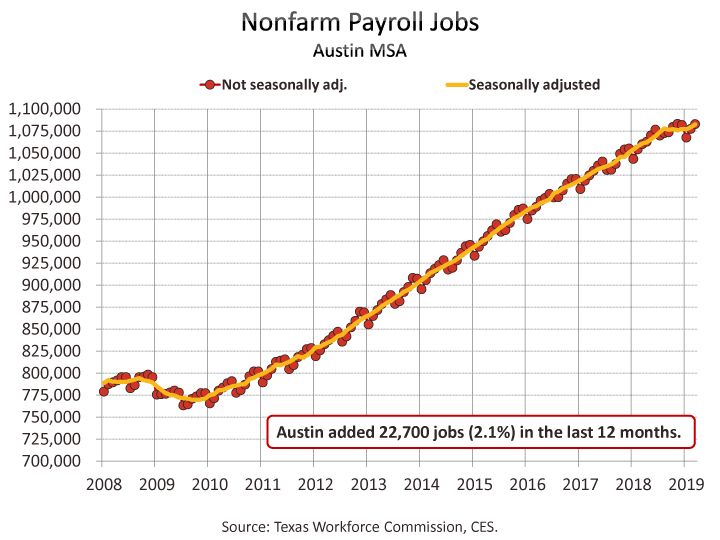
For the year ending in March, private sector growth in the Austin MSA is 2.5%, or 21,900 jobs, with all private industry divisions but two adding jobs. Austin's sizable government sector (17% of jobs) grew by only 800 jobs or 0.4%, thus bringing the overall growth rate to 2.1%.
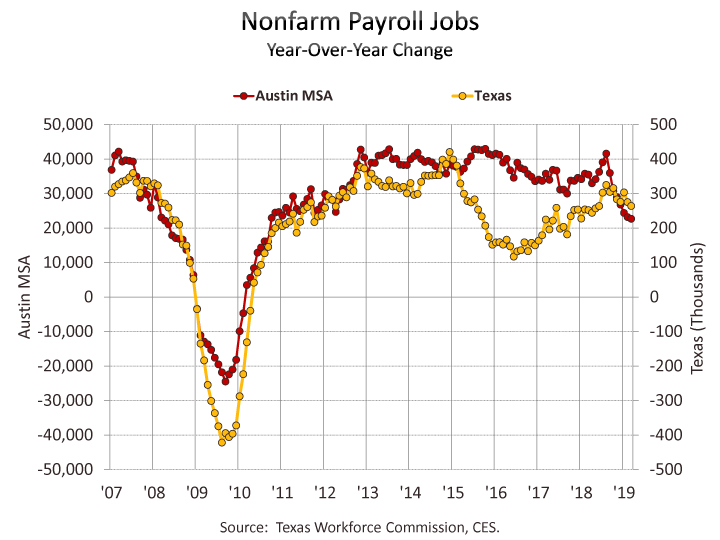
Texas saw net private sector job growth of 2.5% with all private industries but one adding jobs over the last 12 months. Total job growth was 2.1% as the government sector, which accounts for nearly 16% of total state employment, saw slight growth (0.4%). For the nation, private sector growth is 1.9% for the 12 months ending in March with all private industries, but two, adding jobs. Overall job growth is a more modest 1.7% because of minor (0.5%) government sector growth.

Jobs in March are up from the preceding month by 5,400 jobs or 0.5% in the not-seasonally-adjusted series for Austin. In the seasonally adjusted series, growth is also positive, up by 3,300 jobs or 0.3%. Seasonally adjusted jobs are up by 0.5% in Fort Worth, 0.4% in Dallas, and 0.3% in Houston and San Antonio. Statewide, seasonally adjusted jobs are up 22,600 or 0.2%. Nationally, seasonally adjusted jobs are up 0.1% from March.
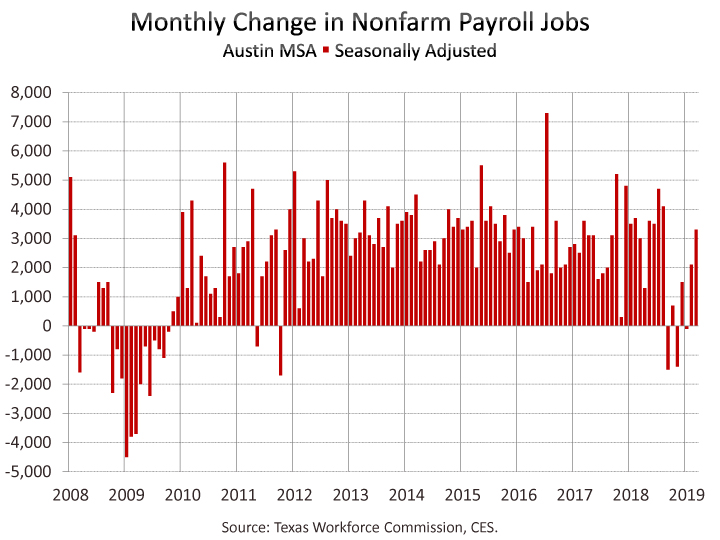
In Austin, professional and business services added the most jobs, 6,000 (3.3%), over the last 12 months. The fastest growing industry was wholesale trade which grew by 8.2% or 4,000 jobs. Also growing at faster-than-average rates are information (5.0% or 1,600), financial activities (4.5% or 2,800), education and health services (3.3% or 4,100), and manufacturing (2.7% or 1,600). Leisure and hospitality is down by 800 jobs or 0.6% and other services is unchanged.
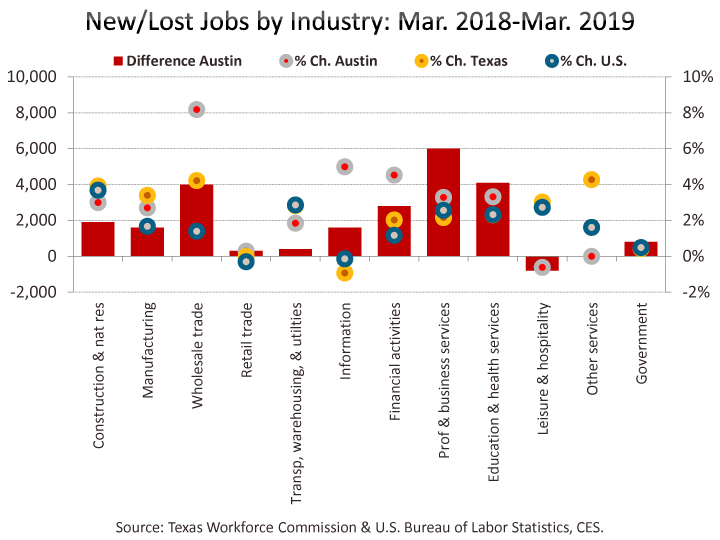
Statewide, other services grew fastest (by 4.3% or 18,200 jobs) over the last 12 months while leisure and hospitality added the most jobs (40,500 or 3.0%). The other relatively fast growing industries were wholesale trade (4.2%), construction and natural resources (3.9%), and manufacturing (3.4%). Information jobs fell by 0.9% and retail trade was essentially unchanged (down by a scant 0.02%).
Nationally, construction and natural resources grew fastest, adding 3.7% over the 12 months ending in March. Transportation, warehousing, and utilities (2.9%); leisure and hospitality (2.7%); and professional and business services (2.6%) were also relatively fast growing. Retail trade and information lost jobs (0.3% and 0.1% respectively).
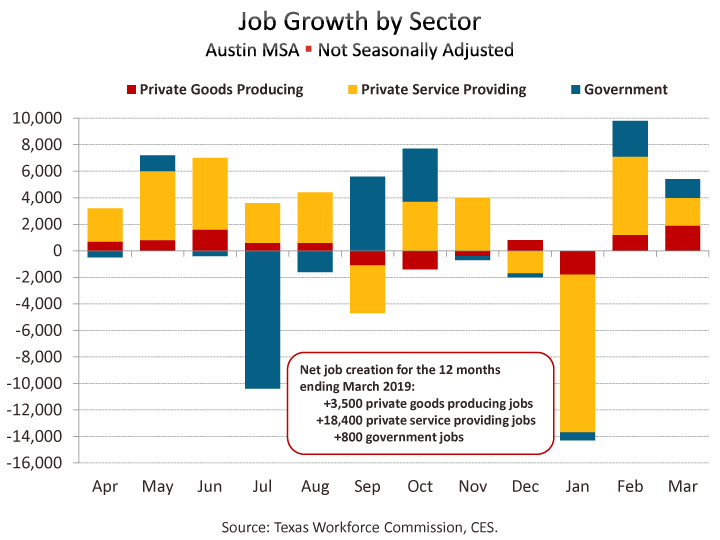
The net gain for private service-providing industries in Austin is 18,400 jobs, or 2.4%, over the last 12 months. Employment in goods producing industries is up by 3,500 jobs or 2.9%. Statewide, private service-providing industries are up 188,300, or 2.2%, and goods producing industries are up 67,400 jobs, or 3.7%.
We also now have March labor force, employment, and unemployment numbers for Texas and local areas in Texas. The same data for all U.S. metros will not be released until May 1. In February, Austin had the fifth lowest rate of unemployment among the 50 largest metros.
Unemployment numbers for March show Austin’s performance relative to the state and other major Texas metros being sustained. In March, Austin is at 2.7%, while the other major metros range from 3.1% in San Antonio to 3.7% in Houston. Dallas and Fort Worth are at 3.3%. Austin’s rate one year ago was 3.0%. The rates in the other major Texas metros are also improved from a year ago. The statewide not-seasonally-adjusted rate is now 3.5%, down from 4.0% in March of last year. The national unemployment rate is 3.9%, improved from 4.1% a year ago.

Within the Austin MSA, Travis County has the lowest unemployment rate in March, at 2.6%, while Caldwell County has the highest at 3.4%. The rate is 2.8% in Hays County, 2.9% in Williamson County, and 3.0% in Bastrop County.
On a seasonally adjusted basis, Austin’s March unemployment rate is 2.7%, down from 2.9% in February. The statewide seasonally adjusted rate is 3.8% in March, unchanged from February. The national rate is also 3.8% in both March and February.
Among Texas’ major metros, San Antonio has the next lowest seasonally adjusted rate at 3.1%, Dallas is at 3.2%, Fort Worth is at 3.3%, and Houston is at 3.8%. Each metro’s rate is improved from February. Seasonally adjusted unemployment rates for Texas metros are produced by the Federal Reserve Bank of Dallas. (The TWC also produces seasonally adjusted rates for Texas metros, but publication lags the Dallas Fed’s data.)

With Austin’s unemployment rate down from one year ago, the number unemployed has also fallen. In March 2018, Austin’s number of unemployed was 36,284. Over the last 12 months, the unemployed declined by 3,169 or 8.7%, to 33,115. This is due to a larger increase in the number employed, compared to labor force. The Austin metro’s civilian labor force (employed plus unemployed) increased by 21,904 persons or 1.8% from one year ago, while persons employed increased by 25,073 or 2.2%.

Texas’ employment growth (302,265 or 2.3%) also exceeds labor force growth (240,879 or 1.7%). Thus, the number of unemployed decreased by 61,386 or 11.0%. Nationally, March civilian labor force is up by 1.3 million or 0.8%, while employed is above the level of a year ago by 1.6 million or 1.0%, and 289,000 fewer people (4.3%) are unemployed.
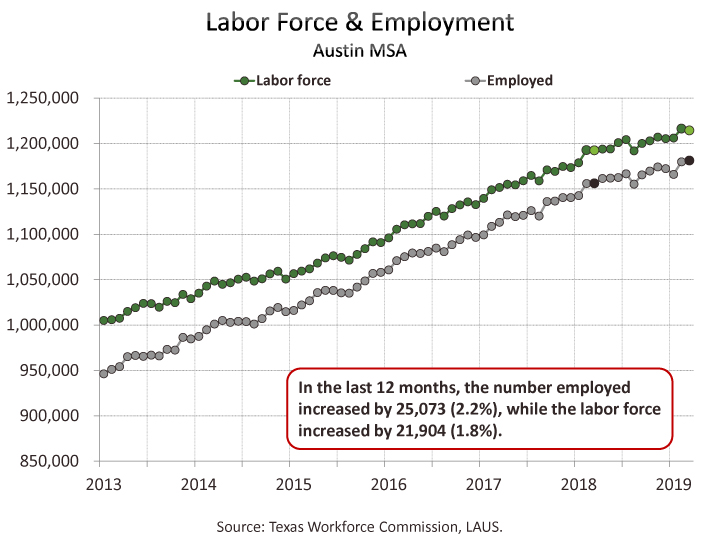

The TWC and the BLS will release April estimates on May 17.
The Chamber’s Economic Indicators page provides up-to-date historical spreadsheet versions of Austin, Texas and U.S. data for both the Current Employment Statistics (CES) and Local Area Unemployment Statistics (LAUS) data addressed above.
FOOTNOTE
[1] Year-over-year job growth of only 2.1% is a rate not seen in Austin since 2010. It is also a rare occurrence for Austin’s job growth to be as low as that of the state. While there are reasons job growth could be slowing down, such as our relatively low unemployment, it’s also helpful to keep in mind the limitations of early estimates. These monthly payroll employment estimates are derived from a sample survey and are subject to an annual revision process that benchmarks the survey estimates against the much more comprehensive counts produced by the Quarterly Census of Employment and Wages (QCEW). Current estimates are based on QCEW data through the third quarter of 2018. While the estimate for March will be revised next month when the April estimate is released, no estimates will be benchmarked by the BLS against QCEW again until next year. At this point, there is little basis for determining if growth has really slowed to 2.1%, or if the estimates are in error (perhaps due to deficient sample quality for the Austin metro). The Dallas Fed produces an alternative payroll jobs series which benchmarks against QCEW quarterly. However, since QCEW lags about six months, their series does not yet reflect any quarters of QCEW not already informing the BLS estimates. The graph below compares the preliminary year-over-year job growth estimates as of March of each year to the “actual” growth rates as reflected in the benchmarked revisions.
